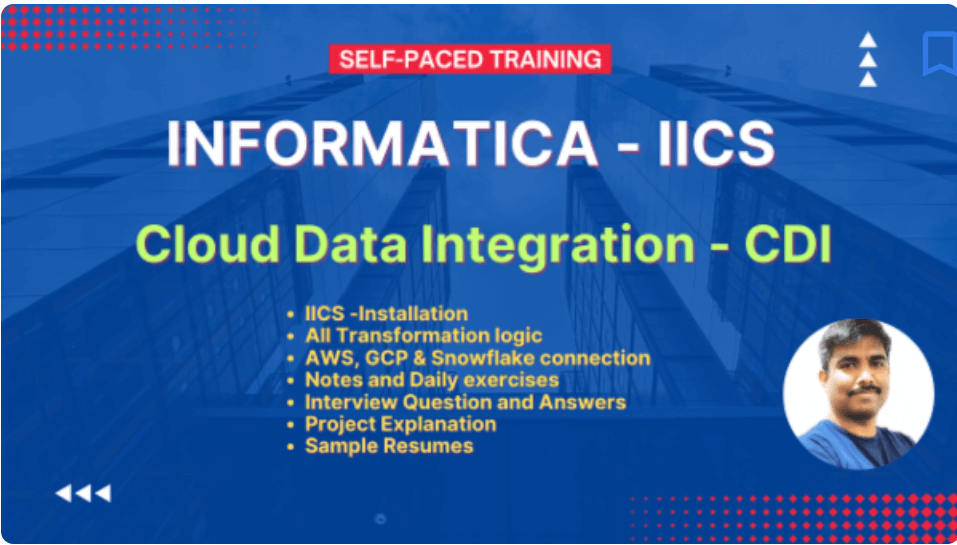Informatica IDMC/IICS interview questions and answers
61. Name the transformations that are present in PowerCenter but not in the Cloud.
- Source Qualifier Transformation
- Update Strategy Transformation
- Stored Procedure Transformation
62. How does IICS ensure data security?
IICS ensures data security through various measures such as:
Data Encryption: All data in transit and at rest is encrypted.
Access Control: IICS uses role-based access control (RBAC) to ensure that only authorized individuals can access the data.
Audit Trails: IICS maintains a detailed log of all activities for audit purposes.
Example: If a company is using IICS for data integration, the data being transferred from one system to another will be encrypted. This means that even if a hacker intercepts the data, they won’t be able to read it due to the encryption.
63. What is the role of a Data Integration Service in IICS?
The Data Integration Service in IICS is responsible for executing tasks. It reads data from sources, applies transformations, and writes the transformed data to targets. The service can execute multiple tasks concurrently, and it can scale to handle large volumes of data.
64. What is a Secure Agent in IICS?
A Secure Agent is a lightweight, self-updating program that you install on a machine in your network. It runs tasks and allows IICS to interact with your local and cloud resources securely. The Secure Agent communicates with IICS over HTTPS, ensuring that all data is encrypted.
Example: If a company wants to use IICS to integrate data from an on-premises database with a cloud-based application, they would need to install a Secure Agent on a machine that can access the on-premises database. The Secure Agent would then facilitate the secure transfer of data between the database and IICS.
65. How can we handle large data volumes in IICS?
IICS handles large data volumes through a combination of techniques:
- Partitioning: IICS can divide data into smaller, more manageable chunks, or partitions, and process each partition separately.
- Pushdown Optimization: IICS can push the processing of data down to the database level, reducing the amount of data that needs to be transferred.
- High-Speed Connectors: IICS offers high-speed connectors for various data sources, enabling faster data transfer
66. What is Flow Run Order in Informatica Cloud?
When there are individual data flows in a mapping, the order in which the data integration processes the flows can be configured in Informatica Cloud Data Integration using Flow Run Order. This is analogous to the Target Load Plan in the Informatica PowerCenter.
A flow is a collection of all connected sources, transformations, and targets in a mapping. You can have multiple flows in a mapping. Specify the flow run order when you want Data Integration to load the targets in different flows in the mapping in a particular order.
67. What are Preprocessing and Postprocessing commands in IICS?
The Preprocessing and postprocessing commands are available in the Schedule tab of tasks to perform additional jobs using SQL commands or Operating system commands. The task runs preprocessing commands before it reads the source. It runs postprocessing commands after it writes to the target. The task fails if If any command in the preprocessing or postprocessing scripts fail.
68. What is Pushdown Optimization in IICS?
Pushdown Optimization in IICS is a feature that allows you to push the processing of transformation logic down to the database level. This can improve performance by reducing the amount of data that needs to be transferred between the database and IICS.
Example: If a company is using IICS to process a large amount of data stored in a database, they could use Pushdown Optimization to speed up the process. The transformation logic would be executed in the database, reducing the amount of data that needs to be transferred to IICS.
69. What is a Mapplet in IICS?
A Mapplet in IICS is a reusable object that you can create in the Developer tool. It contains a set of transformations and lets you reuse that transformation logic in multiple mappings.
Example: If a company has a common set of transformations they use to clean and validate customer data, they could create a Mapplet containing these transformations. This Mapplet can then be used in any mapping that needs to clean and validate customer data, ensuring consistency and reducing duplication.
70. What are Field Name conflicts in IICS and how can they be resolved?
When there are fields with same name coming from different transformations into a downstream transformation like a Joiner transformation, the cloud mapping designer generates a Field Name Conflict error. You can either resolve the conflict by renaming the fields in the upstream transformation only or you can create a field rule in downstream transformation to Bulk Rename fields by adding a prefix or a suffix to all incoming fields.
71. What is a taskflow in IICS?
A taskflow in IICS is a sequence of tasks that you can run as a single unit. Taskflows allow you to orchestrate complex workflows that involve multiple tasks. You can define dependencies between tasks, ensuring that they’re executed in the correct order.
Example: Suppose a company has three tasks: one that extracts data from a database, one that transforms the data, and one that loads the data into a cloud application. They could create a taskflow that runs these three tasks in sequence.
72. How to pass data from one mapping to other in Informatica Cloud Data Integration?
The data can be passed from one Mapping task to another in Informatica Cloud Data Integration through a Task flow using parameters. The Mapping Task which passes the data should have an In-Out Parameter defined using SetVariable functions. The Mapping Task which receives the data should either have an Input parameter or an In-Out Parameter defined in the mapping to read the data passed from upstream task.
73. What are Secure Agent Groups?
By default after you install and register an Informatica Cloud Secure Agent, a Secure Agent Group is created and the installed Secure Agent is added under that group. All the secure agent groups created in the Org can viewed from the Runtime Environments page of Administrator Service.
You can either create a new secure agent group and add multiple secure agents under it or add new secure agents in the existing secure agent group.
74. Do we have a debugger in IICS?
Informatica Cloud debugger lets you preview data at any point in a mapping, even as you build it, which helps in troubleshooting the errors in Data Integration mappings. The only requirement is that the mapping should be valid up to the selected transformation.
Consider a scenario where you have built a mapping but the output of the mapping is not as expected. It could be because the data is getting transformed mid-way in the mapping in an unexpected way. Instead of adding a temporary target to view how the data is transformed at any particular transformation in a mapping, Informatica debugger could be used.
75. What is a Web Services Consumer transformation in IICS?
A Web Services Consumer transformation in IICS is a transformation that can call a web service. The transformation sends a request to the web service, receives the response, and makes the response data available for further processing.
Example: Suppose a company wants to use IICS to integrate data from a web service. They could use a Web Services Consumer transformation to call the web service and process the response data.
76. What is a Lookup transformation in IICS?
A Lookup transformation in IICS is a transformation that can look up data in a source and add it to the output data. The transformation matches records based on a set of lookup conditions.
Example: If a company wants to use IICS to enrich sales data with customer details, they could use a Lookup transformation. The transformation would look up the customer details in a customer database based on the customer ID in the sales data.
77. What is a Joiner transformation in IICS?
A Joiner transformation in IICS is a transformation that can join data from two sources based on a set of join conditions. The transformation matches records from the two sources and combines them into a single record.
Example: Suppose a company wants to use IICS to combine sales data from a sales database with customer details from a customer database. They could use a Joiner transformation to join the sales data and the customer details based on the customer ID.
78. What is a Filter transformation in IICS?
A Filter transformation in IICS is a transformation that can filter data based on a set of filter conditions. The transformation passes through only the records that meet the filter conditions.
Example: If a company wants to use IICS to process sales data, but they only want to include sales from the last quarter, they could use a Filter transformation. The transformation would filter out any sales that occurred before the start of the last quarter.
79. What is an Aggregator transformation in IICS?
An Aggregator transformation in IICS is a transformation that can aggregate data. The transformation groups data based on a set of group by fields, and it calculates aggregate values for each group.
Example: Suppose a company wants to use IICS to calculate the total sales for each region. They could use an Aggregator transformation to group the sales data by the ‘region’ field and calculate the sum of the ‘sales’ field for each group.
80. What is a Sorter transformation in IICS?
A Sorter transformation in IICS is a transformation that can sort data. The transformation sorts data based on a set of sort conditions.
Example: If a company wants to use IICS to process sales data, and they want the data sorted by the ‘sales’ field in descending order, they could use a Sorter transformation. The transformation would sort the sales data, ensuring that the highest sales amounts appear first.
Enroll for Informatica IICS Cloud Data Integration(CDI) – Self-Paced courses
![]()



